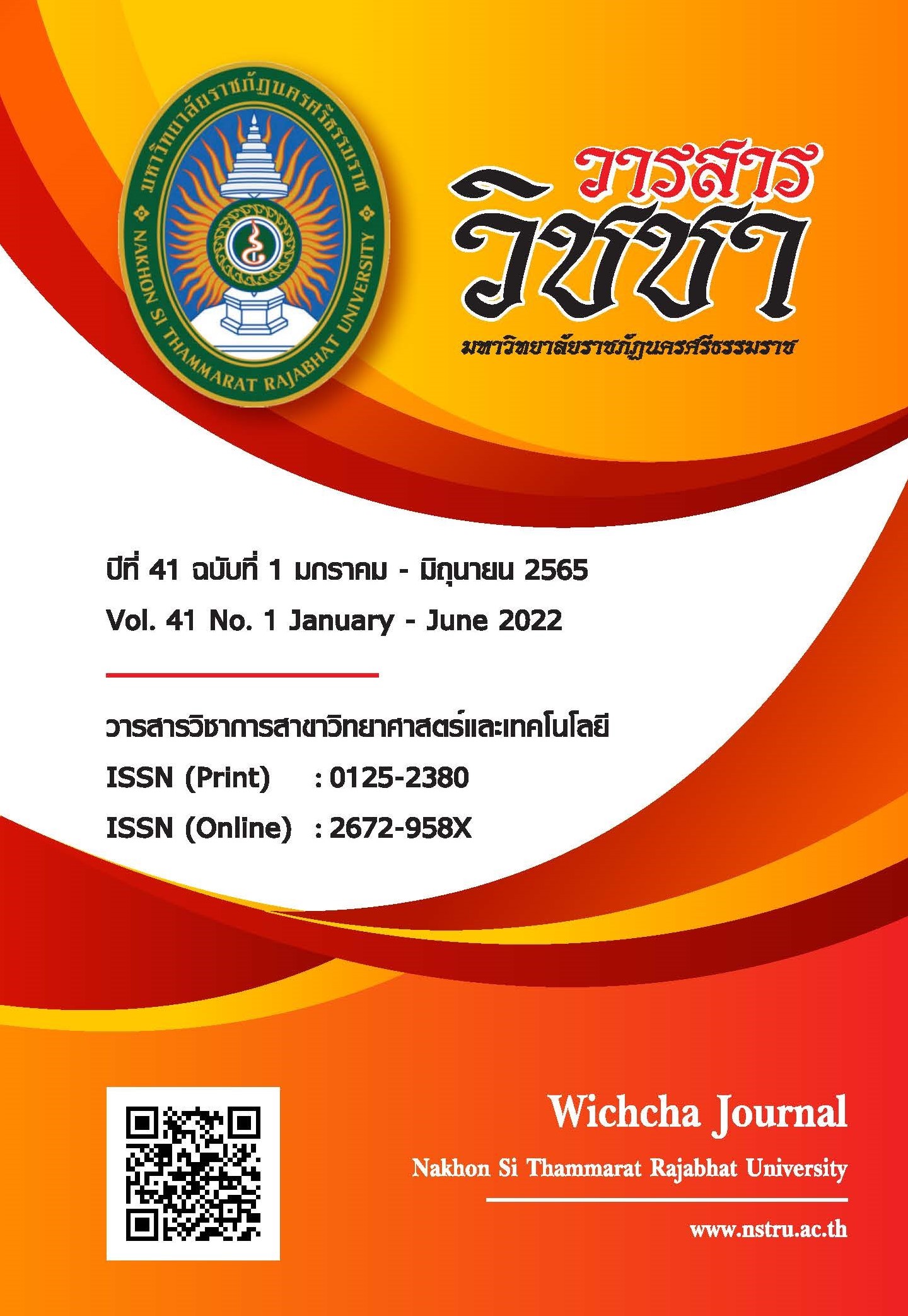Financial Return Assessment of Wind Power Plant under Uncertainty by Stochastic Process
Main Article Content
Abstract
Thailand’s targets about wind power were set in the alternative energy development plan. Needs for wind power increase to more than 1,673 MW within 2036. However, it was found that the current assessment on return on investment of the project by the deterministic process could not determine the uncertainty and caused the investors lacking of confidence to invest in the wind power projects. Therefore, this research aimed to develop the assessment of the wind power projects by using the stochastic process that concerning about uncertainty factors of the projects that impacted on the returns of the projects. This will increase the confidence to invest in wind power projects. The results of the assessment found that 1) the analysis of returns on investment from the deterministic process can calculate the equity’s net present value that equals to 15,253,051 baht 2) the analysis of returns on investment from the Stochastic process by simulating 50,000 times of Matlab program found that the expected of equity’s net present value equals to 22,915,000 baht. The chance of loss was 0.23%. The minimum and maximum probabilities of the equity’s net present value equals to -8,187,800 and 61,597,000 baht respectively
Article Details

This work is licensed under a Creative Commons Attribution-NonCommercial-NoDerivatives 4.0 International License.
เนื้อหาและข้อมูลในบทความที่ลงตีพิมพ์ในวารสารวิชชา มหาวิทยาลัยราชภัฏนครศรีธรรมราช ถือเป็นข้อคิดเห็นและความรับผิดชอบของผู้เขียนบทความโดยตรง ซึ่งกองบรรณาธิการวารสารไม่จำเป็นต้องเห็นด้วยหรือร่วมรับผิดชอบใด ๆ
บทความ ข้อมูล เนื้อหา รูปภาพ ฯลฯ ที่ได้รับการตีพิมพ์ในวารสารวิชชา มหาวิทยาลัยราชภัฏนครศรีธรรมราช ถือเป็นลิขสิทธ์ของวารสารวิชชา มหาวิทยาลัยราชภัฏนครศรีธรรมราช หากบุคคลหรือหน่วยงานใดต้องการนำข้อมูลทั้งหมดหรือส่วนหนึ่งส่วนใดไปเผยแพร่ต่อหรือเพื่อการกระทำการใด ๆ จะต้องได้รับอนุญาตเป็นลายลักษณ์อักษรจากวารสารวิชชา มหาวิทยาลัยราชภัฏนครศรีธรรมราชก่อนเท่านั้น
The content and information in the article published in Wichcha journal Nakhon Si Thammarat Rajabhat University, It is the opinion and responsibility of the author of the article. The editorial journals do not need to agree. Or share any responsibility.
References
กรมพัฒนาพลังงานทดแทนและอนุรักษ์พลังงาน. (2562). แผนพัฒนาพลังงานทดแทนและพลังงานทางเลือก พ.ศ. 2558-2579 (AEDP2015). สืบค้นเมื่อ 5 เมษายน 2562, จาก: https://www.dede.go.th/download/files/AEDP%20Action%20Plan_Final.pdf.
กรมพัฒนาพลังงานทดแทนและอนุรักษ์พลังงาน. (2563). คู่มือการพัฒนาการลงทุนผลิตพลังงานทดแทน ชุดที่ 1 ไฟฟ้า พลังงานลม. สืบค้นเมื่อ 5 มกราคม 2563, จาก: https://www.dede.go.th/article_attach/h_wind.pdf.
กระทรวงพลังงาน. (2562). แผนปฏิบัติการพัฒนาพลังงานทดแทนและพลังงานทางเลือก พ.ศ. 2558-2579. สืบค้นเมื่อ 5 เมษายน 2562, จาก: http://www.eppo.go.th/index.php/th/plan-policy/tieb/aedp.
ชนะ จันทร์ฉ่ำ นฤทธิ์ กล่อมพงษ์ วรพงศ์ พวงแก้ว และจอมภพ แววศักดิ์. (2552). การวิเคราะห์ศักยภาพลมบริเวณอำเภอหัวไทรในจังหวัดนครศรีธรรมราช. วารสารมหาวิทยาลัยทักษิณ, 12(2), 10-19.
ธัชชา สามพิมพ์. (2563). ประเมินผลตอบแทนทางการเงินของโรงไฟฟ้าพลังงานแสงอาทิตย์ ภายใต้นโยบายสนับสนุนส่วนเพิ่มอัตราการรับซื้อไฟฟ้าโดยภาครัฐ. วารสารวิชชา มหาวิทยาลัยราชภัฏนครศรีธรรมราช, 39(1), 126-139.
บดินทร์ เสนานนท์ กัญญานัฐ ทองเทพ กมล จิรเสรีอมรกุล วันจักรี เล่นวารี เสริมสุข บัวเจริญ และ ยิ่งรักษ์ อรรถเวชกุล. (2562). การวิเคราะห์เศรษฐศาสตร์โรงไฟฟ้าพลังงานแสงอาทิตย์ 8 เมกะวัตต์ระหว่างการติดตั้งแบบระบบคงที่กับแบบระบบติดตามดวงอาทิตย์ในประเทศไทย. วารสารวิชาการมหาวิทยาลัยราชภัฏอุตรดิตถ์, 14(2), 1-19.
ปฐมทัศน์ จิระเดชะ. (2553). การพัฒนาพลังงานหมุนเวียนเพื่อการผลิตไฟฟ้าในประเทศไทย. วารสารมหาวิทยาลัยศรีนครินทรวิโรฒ (สาขาวิทยาศาสตร์และเทคโนโลยี), 4(2), 10-24.
Bartolomeu, F., Jorge, C. and Paula, F. (2011). The use of real options approach in energy sector investments. Renewable and Sustainable Energy Reviews, 15(9), 4491-4497.
Chul, K. (2021). A review of the deployment programs, impact, and barriers of renewable energy policies in Korea. Renewable and Sustainable Energy Reviews, 144, doi: https://doi.org/10.1016/j.rser.2021.110870.
Cory, K., Couture, T. and Kreyci, C. (2009). Feed-in tariff policy: Design, implementation, and RPS policy interactions. National Renewable Energy Laboratory’s Technical Report, doi: https://doi.org/10.2172/951016.
Dan, H. and Sarah, M.R. (2019). Stochastic vs. deterministic scheduling of a combined natural gas and power system with uncertain wind energy. Electrical Power & Energy Systems, 108, 303-313.
Dixit, R.K. and Pindyck, R.S. (2012). Investment under uncertainty. New Jersey: Princeton University press.
Li, C.B., Lu, G.S. and Wu, S. (2013). The investment risk analysis of wind power project in China. Renewable energy, 50, 481-487.
Pita, P., Tia, W., Suksuntornsiri, P., Limpitipanick, P. and Limmeechockchai, B. (2015). Assessment of feed-in policy in Thailand: Impacts on national electricity prices. Energy Procedia, 79, 584-589.
Sampim, T. and Kokkaew, N. (2013). Modelling of government support in biopower plant projects: The case of Thailand. Energy Procedia, 52, 525-535.
Sampim, T. and Kokkaew, N. (2017). Risk management in biomass power plants using fuel switching flexibility. Energy Procedia, 138, 1099-1104.
Sopitsuda, T. and Chris, G. (2013). An assessment of Thailand’s feed-in tariff program. Renewable Energy, 60, 439-445.
Tongsopit, S. (2015). Thailand’s feed-in tariff for residential rooftop solar PV systems: Progress so far. Energy for Sustainable Development, 29, 127-134.
Tongsopit, S., Junlakarn, S., Wibulpolprasert, W., Chaianong, A., Kokchang, P. and Nghia, V.H. (2019). The economics of solar PV self-consumption in Thailand. Renewable Energy, 138, 395-408.
Wesseh, Jr.P.K. and Lin, B., (2016). A real options valuation of Chinese wind energy technologies for power generation: Do benefits from the feed-in tariffs outweigh costs?. Journal of Cleaner Production, 112, 1591-1599.
Zhang, M.M., Zhou, P. and Zhou, D.Q. (2016). A real options model for renewable energy investment with application to solar photovoltaic power generation in China. Energy Economics, 59, 213-226.


